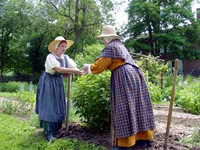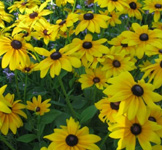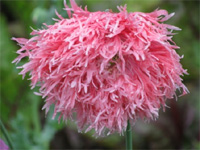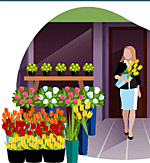Wylie House Museum’s Heirloom Garden
 Growing and saving seed from heirloom flowers and vegetables is a focus of the Wylie House Museum, 317 East Second Street, Bloomington, Indiana.
Growing and saving seed from heirloom flowers and vegetables is a focus of the Wylie House Museum, 317 East Second Street, Bloomington, Indiana.
The house has a full time Outdoor Interpreter who is responsible for planning the garden and overseeing the work of local gardeners who volunteer there. While the exact varieties that the Andrew Wylie family grew in the 1840s are unknown, the seeds selected to grow there are all heirloom varieties that were grown in this area prior to 1850.
Not so long ago, seed saving was part of every garden. From ancient times until our grandparents’ day, favorite strains of vegetables and flowers were renewed from year to year and generation to generation, sometimes travelling long distances with a family to a new homeland. By the 1880s, seed companies had begun to make hybrid seeds widely and inexpensively available, and by the early 20th century many gardeners no longer saved their own seed, relying instead on the seed companies to provide new and improved varieties each year. Nearly a century later, it is uncommon to find a gardener who saves seed.
Heirloom gardening is the preservation of old and valued plant varieties. In recent decades, many varieties of flowers, fruits and vegetables which had been prized and maintained for generations have been lost. But a growing number of gardeners are seeking out those heirlooms which still remain and working to keep them a living part of our garden heritage. Many seed savers also have a particular interest in preserving native plant species.

Black-Eyed Susans
1. Waste not, want not. Saving seed appeals to the thrifty nature which hates to see any good thing go unused or unappreciated. The seed saver knows the satisfaction of gathering up seed, storing it carefully away for next year’s garden, preserving for another season some nearly-forgotten but praise-worthy bean.
2. Suit yourself. Hybrids may boast hardiness and disease resistance, but you can develop your own vigorous strains over several seasons of selective seed saving. And by saving seed from the plants with the qualities you most prize, you will soonhave varieties that are ideally adapted to your garden andgrowing conditions. As an added plus, many heirloom vegetable gardeners assert that although old varieties are not always prettier than modern types, they are usually tastier!
3. Maintain genetic diversity. A compelling ecological argument for seed saving. As fewer and fewer old varieties of food crops are maintained, the gene pool grows smaller and smaller, and with this diminution comes increased susceptibility to sweeping disease and pest outbreaks, as well as less vigorous gene material for future hybridization. Many ecologists warn that this could prove catastrophic. Seed saving keeps the vegetable world heartily diversified.
4. Practice living history. Seed saving fosters an awareness of the seamless fabric of life and time that we call history. The plant varieties themselves are living links to times past. The activity of seed saving is one we share with untold generations of ancestors. And we are reminded of our responsibility and opportunity to pass these treasures on to future generations.
5. Self-Reliance. Perhaps we are too quick to believe that certain tasks are beyond our skills, and too willing to allow a company somewhere to take care of them for us. As Marc Rogers writes in Saving Seeds, “Any small measure of self-reliance we can recapture in our overly dependent society is cause for satisfaction.” Or as Ralph Waldo Emerson asserts in his essay Self-Reliance, “Trust thyself: Every heart vibrates to that iron string.”
6. Go full circle. By saving seed we participate in an essential part of the life cycle, a part that we miss when we delegate this task to seed companies. The unbroken circle of birth, growth, death and rebirth has awed and inspired mankind from our earliest recorded history. In our gardens, saving seed from season to season, we too can enjoy and take inspiration from the endless cycles of nature. Stored away in a jar, seeds cannot remain viable for long. To preserve them we must plant them, nurture them, let them mature and bear fruit to begin the cycle again.

Double Peony-Flowered Poppy
Built in 1835, Wylie House was the home of Indiana University’s first president, Andrew Wylie, and his family. Today Wylie House is owned and operated by Indiana University as an historic house museum, recreating the Wylie home prior to 1860.






